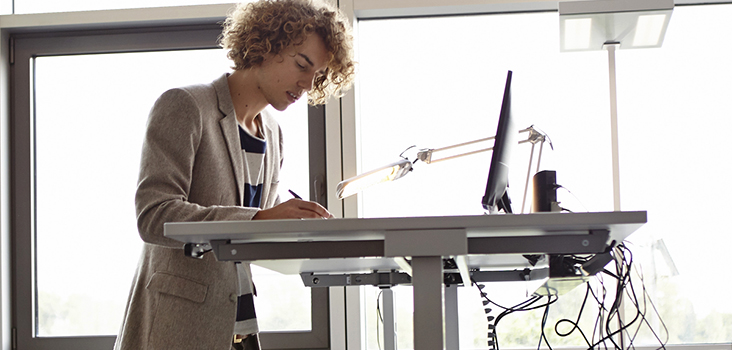
Protecting Millennials and Baby Boomers in the Workplace
The demographics of the workplace are changing. Millennials surpassed Baby Boomers as the largest percentage of the workforce in 2015, with 75.3 million employees between ages 18 and 34. At the same time, older employees are working past the average retirement age.
Juggling the unique risks of each group can be a challenge for employers, but it’s not an impossible task. All it requires is an understanding of what to expect, and what simple adjustments you can make to your existing health and safety program.
New Risks from Millennials’ Relationship with Technology
The millennial generation was raised in a time where technology became more prevalent, and more mobile. The constant use of cell phones, laptops, and tablets has led to poor posture and an expectation to multitask, both of which are risks in the workplace.
Ergonomics assessments to improve posture.
With access to the internet on laptops, tablets, and cell phones, you don’t need to sit at a desk to use the computer anymore. Millennials have spent much of their youth devoted to devices, slumped over in couches and chairs, and heads-down typing in screens. These bad habits may not affect younger workers now, but they can cause serious long-term injuries. Several millennials are already entering the workforce with levels of pre-musculoskeletal (MSD) injury that most workers don’t experience until 10 to 20 years on the job.
The best way to address these injury-causing behaviors is through ergonomic education and adjustments. Millennial employees may not even be aware of how their posture is impacting their health, and they may not realize how much time they spend with their head down. Ergonomic education can cover the effects of poor posture and how to avoid MSD injuries.
To prevent poor posture from causing your employees future injuries, bring an ergonomics expert into your workplace to assess and address risks. These could be simple adjustments, like buying ergonomic chairs, offering standing desks, and reorganizing materials for easy reach.
Clean workplaces to reduce multitask-based injury risks.
The ability to take your work anywhere via mobile technology has a lot of benefits - but it can also be dangerous. Employees who try to read emails on their phone, contribute to a conference call on their headset, and speed walk to their next meeting are a recipe for disaster. Their focus is already split and they are unlikely to be paying attention to their surroundings. If a file cabinet is sticking out or someone spilled their coffee in the hallway, the distracted employee could get hurt.
Even if the employee isn’t paying attention, tripping or slipping in a messy workplace still falls under workers’ compensation. Keeping walkways and busy areas clear and clean is essential for workplace safety. Your company’s safety program should include specific policies and procedures on how to maintain a clean workplace. These can range from simple practices like always closing a drawer you aren’t using or picking up after your own messes, to rules on how a busy work area should be designed.
Changing Needs for an Aging Workforce
Older workers are more experienced, and typically have fewer injuries than their younger coworkers. But the injuries they experience tend to be more severe and long-term, and typically require more complex, expensive treatment. General aging issues, like worsening sight and hearing, and an increased likelihood to develop chronic conditions, leave older workers at a greater risk of injury or illness.
Address work practices for vision and hearing issues.
Whether in an office, on a construction site, or in a factory, a lot of work injuries can be avoided by seeing or hearing the risk before it’s too late. As your employees age, no matter how much experience they have in their role, worsening sight and hearing can create risks that put the older employee and their coworkers in danger.
By making simple adjustments to work practices, employers can develop a safer work environment for older employees.
To address vision issues, employers should:
- Make sure there is enough light for different tasks
- Reduce glare on computer screens
- Use bigger font sizes on important signs and warnings
To address hearing issues, employers should:
- Reduce machine noise levels
- Use sound-absorbing materials in the workplace design
- Offer headphones, either for sound-canceling or sound-enhancing purposes
Wellness programs can help employees manage chronic conditions.
Chronic conditions affect people of all ages, but older adults are at a higher risk of developing them. These conditions, which include heart disease, diabetes, chronic neck or back pain, arthritis, hypertension, and obesity, can seriously impact an employee’s health and ability to work. Employees with chronic conditions often miss work because they’re in pain or are seeking treatment. Between rising health care costs, absenteeism, and lost productivity, these conditions put a big hole in employers’ wallets.
Access to health care at the workplace can help older employees manage their chronic conditions while reducing time away from work. An onsite health center offers convenient, quality medical care for your employees, without the hassle of traveling and wait times. Onsite clinicians can help employees manage their chronic conditions by addressing root causes, like poor nutrition and lack of exercise. This preventive care can treat chronic conditions, and help employees avoid developing them in the first place.
From new risks to old habits, there’s a lot that employers need to consider when protecting their employees. By partnering with an established occupational health provider like Concentra, you gain more than 35 years of experience and resources to keep your workforce safe and healthy. Contact a Concentra work health expert to learn how we can protect your employees, no matter what their age.



